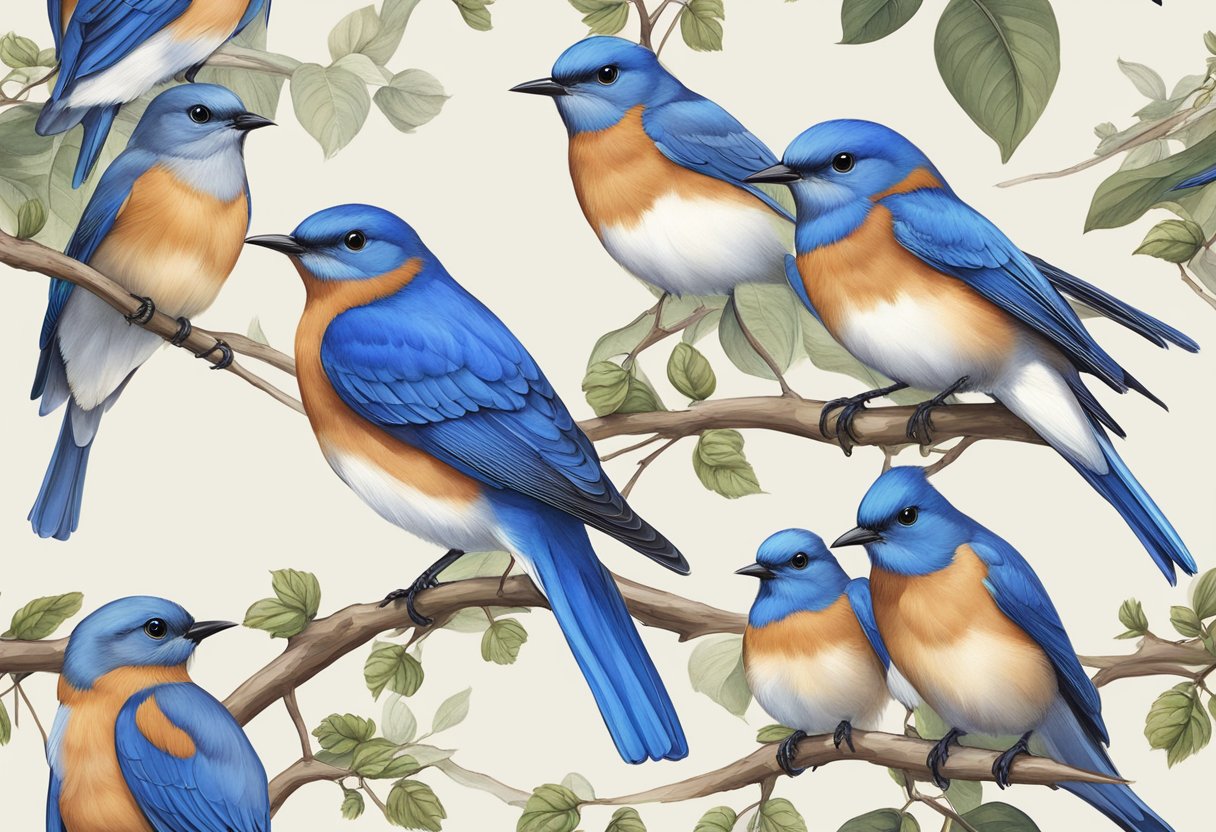Types Of Bluebirds
Bluebirds are small, beautiful birds that are known for their striking blue plumage. They are found throughout North America and are a favorite among bird watchers. There are several different types of bluebirds, each with their own unique characteristics and habits. In this article, we will explore the different types of bluebirds, their physical characteristics, habitats, behaviors, and conservation challenges.
Bluebirds are part of the thrush family and are known for their bright blue feathers. The three main species of bluebirds found in North America are the Eastern Bluebird, the Western Bluebird, and the Mountain Bluebird. Each of these species has its own distinct features and can be found in different parts of the continent. While they share some similarities, such as their love of open fields and meadows, they also have differences in their physical appearance and nesting habits.
Despite their beauty, bluebirds face a number of challenges in the wild. Habitat loss, climate change, and competition from non-native bird species are just a few of the issues that threaten their survival. It is important to understand these challenges and take steps to protect bluebirds and their habitats. By learning more about these amazing birds, we can all work together to ensure that they continue to thrive for generations to come.
Key Takeaways
- Bluebirds are small, beautiful birds known for their striking blue plumage.
- There are three main species of bluebirds in North America: the Eastern Bluebird, the Western Bluebird, and the Mountain Bluebird.
- Bluebirds face a number of challenges in the wild, including habitat loss, climate change, and competition from non-native bird species.
Overview of Bluebird Species

Bluebirds are a group of medium-sized, mostly insectivorous or omnivorous birds in the thrush family (Turdidae) that are native to North America. There are three species of bluebirds found in North America, each with its own unique characteristics and range.
Eastern Bluebird
The Eastern Bluebird (Sialia sialis) is one of the most recognizable and beloved birds in North America. This species is found throughout eastern North America, from southern Canada to the Gulf of Mexico. Eastern Bluebirds are primarily blue in color, with rusty-red breasts and white bellies. The females are duller in color than the males but still have some blue plumage.
Eastern Bluebirds typically nest in tree cavities or man-made nest boxes, and they are known for their melodious songs and cheerful calls. They feed on insects, spiders, and fruit, and are often seen perched on wires or fence posts, hunting for insects.
Western Bluebird
The Western Bluebird (Sialia mexicana) is found in western North America, from southern British Columbia to central Mexico. This species is similar in appearance to the Eastern Bluebird, but has a more vibrant blue coloration with a rusty-red throat and breast. The females are also duller in color than the males.
Western Bluebirds prefer open woodlands and savannas, and are often found in areas with scattered trees and shrubs. They feed on insects, spiders, and fruit, and are known for their cheerful, warbling songs.
Mountain Bluebird
The Mountain Bluebird (Sialia currucoides) is found in the western United States and Canada, primarily in the Rocky Mountains. This species is the most brightly colored of the three bluebirds, with a vibrant blue back, wings, and head, and a white belly. The females are duller in color than the males but still have some blue plumage.
Mountain Bluebirds prefer open habitats such as meadows, grasslands, and sagebrush steppe, and are often seen perched on fence posts or hovering over fields, hunting for insects. They are known for their soft, warbling songs and their habit of nesting in natural cavities or man-made nest boxes.
Overall, bluebirds are a beloved and iconic group of birds in North America, known for their beautiful coloration, cheerful songs, and insect-eating habits. Whether you’re a seasoned birder or a casual observer, these birds are sure to bring a smile to your face.
Physical Characteristics
Bluebirds are small, plump birds that are known for their bright blue plumage. They have short tails and rounded wings, with a wingspan ranging from 9 to 12 inches. The length of a bluebird ranges from 5 to 8 inches, and they weigh between 0.8 and 1.2 ounces.
Plumage and Coloration
Male bluebirds are brightly colored, with a vibrant blue plumage on their heads, backs, and wings. Their chests and undersides are typically white, while their bills are short and pointed. Female bluebirds have a more subdued coloration, with a duller blue hue on their wings and backs. They also have a blend of green and gray-blue feathers, which makes them less colorful than males.
The Mountain Bluebird, which is one of the 17 types of blue-colored birds in North America, has solely blue and white plumage. On the other hand, the Eastern Bluebird has a stunning blue-colored plumage with light orange chests and white undersides. The Western Bluebird, which is found in western North America, has a similar color pattern to the Eastern Bluebird but with a more muted blue hue.
Size and Shape
Bluebirds have a round and stocky body shape, with short pointed bills. They have a short tail, which is often slightly rounded or squared at the tip. The size of a bluebird varies depending on the species, with the Mountain Bluebird being the largest and the Eastern Bluebird being the smallest.
In summary, bluebirds are small, plump birds with short tails and rounded wings. Males are brightly colored with a vibrant blue plumage, while females have a more subdued coloration. The Mountain Bluebird has solely blue and white plumage, while the Eastern and Western Bluebirds have blue plumage with light orange chests and white undersides. The size of a bluebird varies depending on the species, with the Mountain Bluebird being the largest and the Eastern Bluebird being the smallest.
Habitat and Range
Bluebirds are native to North America and are found in a variety of habitats, ranging from open woodlands to urban parks and gardens. They are most commonly found in the eastern half of the United States, southeastern Canada, and south to Mexico, Guatemala, Honduras, Costa Rica, El Salvador, and Costa Rica.
Geographical Distribution
The three species of bluebirds found in North America are the Eastern Bluebird, Western Bluebird, and Mountain Bluebird. The Eastern Bluebird is found in the eastern United States, while the Western Bluebird is found in western North America. The Mountain Bluebird is found in the Rocky Mountains and the western United States.
Preferred Habitats
Bluebirds prefer open woodlands, meadows, and grasslands with scattered trees and shrubs. They also prefer areas with low to moderate elevations, typically below 2,000 meters. Bluebirds are cavity nesters and require suitable nesting sites, such as natural tree cavities or specially designed nest boxes.
Bluebirds are an important part of North America’s bird population and are a joy to observe in their natural habitats.
Behavior and Reproduction
Bluebirds are known for their beautiful plumage and sweet songs, but they also exhibit interesting behaviors and reproduction patterns. Understanding these aspects of bluebird behavior can help bird enthusiasts attract and care for these birds.
Feeding Habits
Bluebirds have a diverse diet that includes insects, berries, and fruit. They are known to forage on the ground for insects and other invertebrates, but they also feed on berries and fruits when available. During the winter months, bluebirds may rely more heavily on fruit to sustain themselves.
Breeding and Nesting
Bluebirds are monogamous and form pairs during the breeding season. They are cavity nesters and often use nest boxes provided by humans. Bluebirds typically produce two to four broods during the breeding season, which runs from March to August in the Northeastern United States.
Nesting
Bluebirds build their nests in cavities, such as abandoned woodpecker holes or nest boxes. They prefer open grasslands with scattered trees, which provide suitable nesting sites. Bluebirds may also use nest boxes provided by humans, which should be placed in open areas and away from other birdhouses.
Broods
Bluebirds typically lay 3-7 eggs per brood, which hatch after about 14 days of incubation. The young birds fledge after about 17 days and are cared for by both parents. Bluebirds may produce multiple broods during the breeding season, which can lead to a high population of bluebirds in an area.
In conclusion, bluebirds exhibit interesting behaviors and reproduction patterns that make them fascinating to observe. Understanding their feeding habits and nesting preferences can help bird enthusiasts attract and care for these beautiful birds. By providing suitable nesting sites and food sources, humans can help ensure the survival of bluebird populations.
Conservation and Challenges
Threats and Predators
Bluebirds face a variety of challenges in their natural habitats. Their primary predators include snakes, raccoons, and domestic cats. Competition for nesting sites and food is also a significant challenge, as other bird species and animals may compete with bluebirds for these resources. Additionally, bluebirds are vulnerable to the introduction of non-native species, such as European Starlings and House Sparrows, which can outcompete them for nesting sites and food.
Conservation Efforts
Many organizations and individuals are working to conserve bluebird populations and protect their habitats. In some states, bluebirds are designated as the state bird, which helps raise awareness of their conservation needs. Additionally, there are efforts to protect bluebird habitats from logging and other forms of habitat destruction.
One of the most successful conservation efforts has been the widespread use of birdhouses. These artificial nesting sites provide bluebirds with safe, secure places to raise their young, and they have been instrumental in increasing bluebird populations in many areas. However, it is important to note that birdhouses must be properly maintained to ensure their effectiveness.
Overall, while bluebirds face significant challenges, there are many conservation efforts underway to protect them and their habitats. By working together, we can help ensure that these beautiful birds continue to thrive for generations to come.






